Research Article - (2022) Volume 11, Issue 6
Received: 04-Jun-2022, Manuscript No. JACM-22-66146;
Editor assigned: 06-Jun-2022, Pre QC No. P-66146;
Reviewed: 12-Jun-2022, QC No. Q-66146;
Revised: 18-Jun-2022, Manuscript No. R-66146;
Published:
24-Jun-2022
, DOI: 10.37421/ 2168-9679.2022.11.475
Citation: Raharimina, L.H.D.L, G. Rasolomampiandry and F. Randimbindrainibe. “One Method for the Numerical Resolution of One Type of Fractional Differential Equation of Euler-Lagrange” J Appl Computat Math 11 (2022): 475.
Copyright: © 2022 Raharimina LHDL, et al. This is an open-access article distributed under the terms of the Creative Commons Attribution License, which permits unrestricted use, distribution, and reproduction in any medium, provided the original author and source are credited.
We propose in this article one method of numerical resolution using the programming under Matlab of one of the fractional differential equations of Euler-Lagrange containing a composition of the left and right fractional derivatives of order α, 0< α<1, of Riemann-Liouville and Caputo respectively.
Numerical resolution • Fractional derivatives • Programming under Matlab
Fractional differential equations are becoming more and more interesting in recent years for scientists. Many authors have already studied different types of problems and have formulated Euler-Lagrange equations with different boundary conditions [1-18]. An ordinary differential equation containing a composition of left and right fractional derivatives to order α, 0< α<1, with boundary conditions, is considered in our work. This type of equation is known as the fractional differential equation of Euler-Lagrange. Fractional differential equations appear in certain fields such as physics, mechanics, electrical engineering, etc... This type of equation can be solved with other methods such as the Laplace transformation or a method using the principle of least action [10,11]. An analytical method using the fixed- point theorem [6,7] also provides a solution, but this method is complicated. This is why we propose another numerical method to solve this type of fractional differential equation. We opted the programming under Matlab language to find this numerical solution.
This work will be presented in four sections: in section 2, we recall the definitions which are necessary tools for the resolution of the equation that we will presented in section 3. In section 4, we propose a numerical solution, at first we search the numerical schemes for both fractional operators occurring in equation and then we determine a developed form of equation in order to establish a system of linear equations that we will transform into matrix form. In the last section, the programming under Matlab language allowing finding approximate numerical solutions graphically and the examples of numerical solution are given.
Preliminaries
In this section, we give some useful definitions for this numerical solution. The left and right fractional integrals in the sense of Riemann-Liouville of order on an interval [0,b] are defined respectively by:


Where Γ is Euler's Gamma function and 
The left and right fractional derivatives of Riemann-Liouville to order α, 0<α<1 are defined from these fractional integrals to order α by:
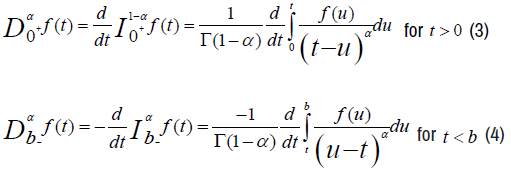
The left and right fractional derivatives to order α in the sense of Caputo are also defined from the left and right fractional integrals of Riemann-Liouville of order α by:
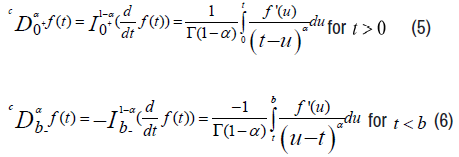
The relationship between the left fractional derivatives of Riemann-Liouville and the left fractional derivative of Caputo, both of orderα , is the following:
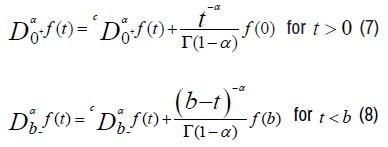
Presentation of the problem
We study in this work, one of type of the fractional differential equation of Euler- Lagrange of order α:

Where: f is the unknown function, g is a given function,  and
and  are
respectively the left fractional derivatives of Riemann-Liouville and the right
fractional derivatives of Caputo, both of order α with 0<α<1 and t∈[0,1], the
boundary conditions are:
are
respectively the left fractional derivatives of Riemann-Liouville and the right
fractional derivatives of Caputo, both of order α with 0<α<1 and t∈[0,1], the
boundary conditions are:
f (0)=0 and f(1)=0 (10)
Numerical resolution
To find the discrete form of equation (9), subdivide the interval [0,1] into N parts
with constant step  , so there exist (N + 1) points ti, i=0,1,...., N on this interval with
, so there exist (N + 1) points ti, i=0,1,...., N on this interval with  are arranged in ascending order.
The discrete value of the function f at each point ti is noted fi=f(ti). And we note
are arranged in ascending order.
The discrete value of the function f at each point ti is noted fi=f(ti). And we note  the derivative of the function f at the point ti The finite difference scheme of order 1 is written:
the derivative of the function f at the point ti The finite difference scheme of order 1 is written:

This scheme allows us to find the approximate value of the derivative of the function fi at each point ti.
We determine the discrete form of this equation (9) and translate the equation obtained in matrix form.
Here are the different steps to follow to find this discrete form of the equation (9).
We will present the discrete form of each type of fractional derivative, firstly the left fractional derivative of Riemann-Liouville and secondly the right fractional derivative of Caputo, of order α,0<α<1 [9,14].
Approximation of the fractional derivative of Riemann-Liouville of order α at point ti.
For this, we will use the relation (7) between the left fractional derivative of Riemann-Liouville and the left fractional derivative of Caputo of order α
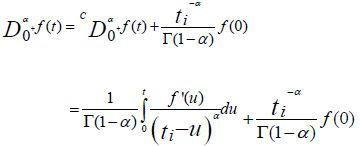
By using the approximation of the derivative by the method of finite differences (11) and by decomposing the integral, we obtain the following relation:

But the calculation of the integral  gives,
gives,

Substitute the integral by the relation (12), we get:
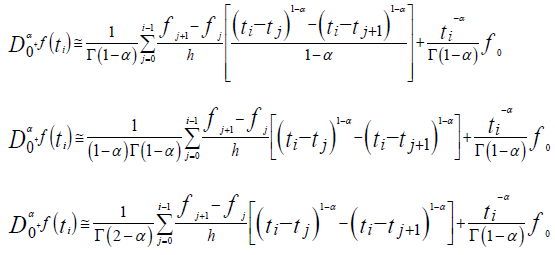
Since ti = ih and tj = jh then we have,

By factoring h1-α we get the following equality:
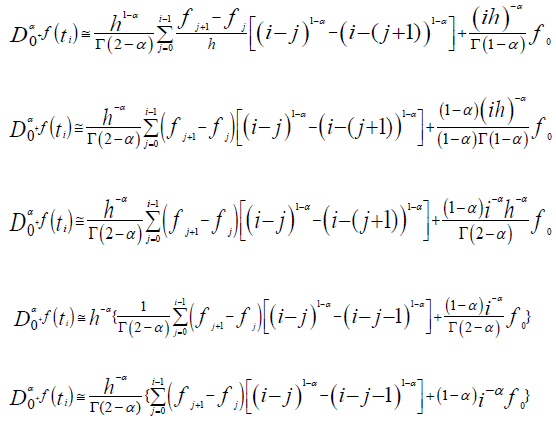
For j from 0 to i, we obtain the coefficients of fj, noted h-αci,j with:
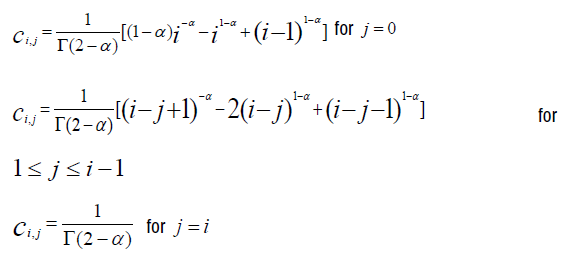
The approximation of the right fractional derivative of Caputo of order α for the function ϕ is,

at point ti, using the formulate of method of finite differences (11) and decomposition of the integral (12), we have:


Substitute ti and tj by ih and jh, the approximation becomes:
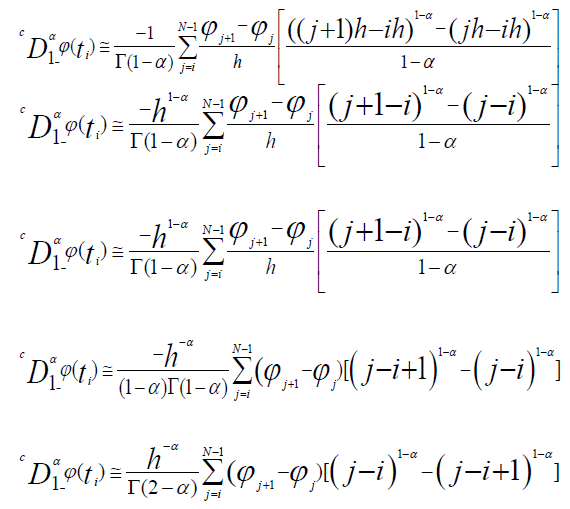
For i ≤ j ≤ N−1, we obtain the coefficients noted h-α di,j of the function ϕj, with:
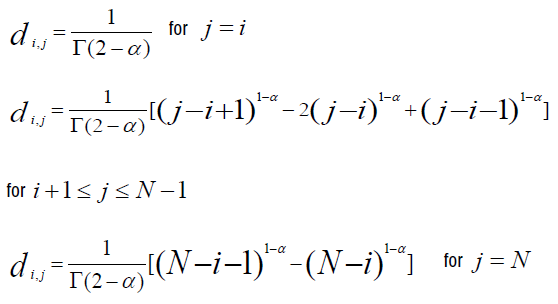
Thus, by composition of the two operators, we can write the initial equation (9) in the following discrete form:

For i ranging from 1 to N-1, we get, for each value of i, the following expanded form:

Where the coefficients  , are defined by:
, are defined by:
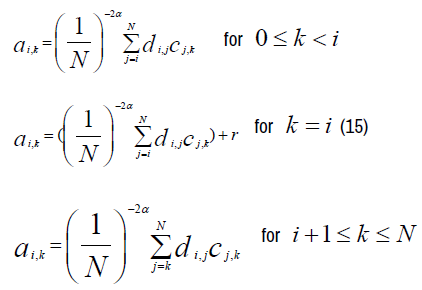
Thus, we can write the following system of N+1 equations of unknowns fi.
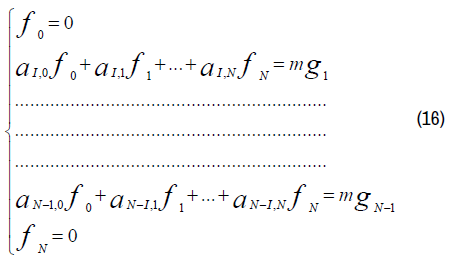
This system can be translated by matrix form:
 where: (17)
where: (17)
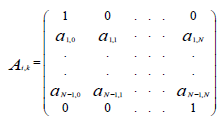 , the matrix of the coefficients of fi of the system
, the matrix of the coefficients of fi of the system
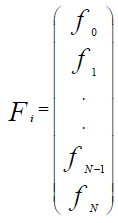 the matrix of unknowns fi with i rows, 0≤i≤N
the matrix of unknowns fi with i rows, 0≤i≤N
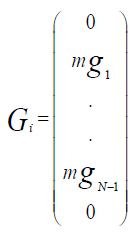 the matrix equation of the second member.
the matrix equation of the second member.
These coefficients can be calculated with programming under Matlab language that we will present below.
Programming under Matlab language and numerical examples
In this programming, firstly, we presented the case where N fixed and α varies and secondly the case where α fixed and N varies to know the influences of the values of N and those of the values of α in the results obtained graphically.
The following programming allow us to calculate step by step these coefficients cj,k, di,j, ai,k in order to represent the functions f(N,α) graphically.
In this section, the numerical results of calculations are presented. In presented solutions of equations, we assume the following parameters: for N fixed, we choose two values of N, N=100 and N=200, α ∈{0,0.1,0.2,0.8,0.9,1} but for α fixed, α = 0.1, α = 0.8, α = 0.9 , N∈{200, 300, 500, 1000}. Here, the function g, the constant r and m are given in the programming. These values of g, r and m can be changed in this programming.
In this example of programming, we take g(t) = 2π2 sin(π t), r =π2, m = 2π2 (17).


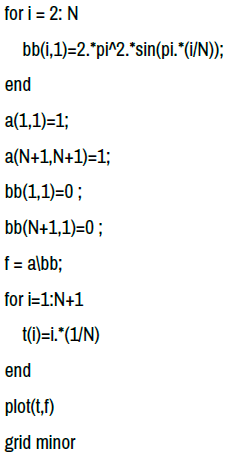
Analyzing the graphical representations seen previously, we note that when α is fixed and N varies then the shape of all the curves are the same and they are confused for all the values of N but the maximum value of the approximate solution fi reached is the same at the point ti=0.5, and decreases when the value of increases. For fixed N and variable, the shape of the curves does not change and the curves are different for different values of α but the maximum values of the functions fi as a function of ti remain the same for different values of N. We also observe that when α is close to 0 then the curves approach the curve corresponding to α=0 and they approach the curve corresponding to α=1 when α is close to 1 (Figures 1 and 2).
In our work, we opted for a numerical method using programming under Matlab one of the methods allowing to find the coefficients of the matrix in order to obtain approximate solutions of the function at the point for two different cases by fixing and by varying and by fixing and by varying. Our perspective is to apply this method for different problems in certain fields such as sciences, mechanics, etc.
Journal of Applied & Computational Mathematics received 1282 citations as per Google Scholar report